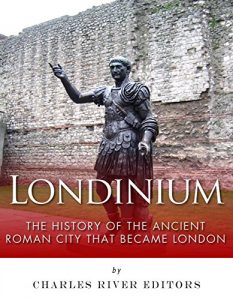*Includes pictures
*Profiles Londinium's history, culture, buildings, and religious practices
*Includes online resources and a bibliography for further reading
*Includes a table of contents
The famous conqueror from the European continent came ashore with thousands of men, ready to set up a new kingdom in England. The Britons had resisted the amphibious invasion from the moment his forces landed, but he was able to push forward. In a large winter battle, the Britons’ large army attacked the invaders but was eventually routed, and the conqueror was able to set up a new kingdom.
Over 1,100 years before William the Conqueror became the King of England after the Battle of Hastings, Julius Caesar came, saw, and conquered part of “Britannia,” setting up a Roman province with a puppet king in 54 B.C. In the new province, the Romans eventually constructed a military outpost overlooking a bridge across the River Thames. The new outpost was named Londinium, and it covered just over two dozen acres.
For most of the past 1,000 years, London has been the most dominant city in the world, ruling over so much land that it was said the Sun never set on the British Empire. With the possible exception of Rome, no city has ever been more important or influential than London in human history. Thus, it was only fitting that it was the Romans who established London as a prominent city.
Londinium was initially little more than a small military outpost near the northern boundary of the Roman province of Britannia, but its access to the River Thames and the North Sea made it a valuable location for a port. During the middle of the first century A.D., the Romans conducted another invasion of the British Isles, after which Londinium began to grow rapidly. As the Romans stationed legions there to defend against the Britons, Londinium became a thriving international port, allowing trade with Rome and other cities across the empire.
By the 2nd century A.D., Londinium was a large Roman city, with tens of thousands of inhabitants using villas, palaces, a forum, temples, and baths. The Roman governor ruled from the city in a basilica that served as the seat of government. What was once a 30 acre outpost now spanned 300 acres and was home to nearly 15,000 people, including Roman soldiers, officials and foreign merchants. The Romans also built heavy defenses for the city, constructing several forts and the massive London Wall, parts of which are still scattered across the city today.
Ancient Roman remains continue to dot London’s landscape today, reminding everyone that almost a millennium before it became the home of royalty, London was already a center of power.
Londinium: The History of the Ancient Roman City that Became London analyzes the history of this influential Roman settlement. Along with pictures of important people, places, and events, you will learn about Londinium like never before, in no time at all.
*Profiles Londinium's history, culture, buildings, and religious practices
*Includes online resources and a bibliography for further reading
*Includes a table of contents
The famous conqueror from the European continent came ashore with thousands of men, ready to set up a new kingdom in England. The Britons had resisted the amphibious invasion from the moment his forces landed, but he was able to push forward. In a large winter battle, the Britons’ large army attacked the invaders but was eventually routed, and the conqueror was able to set up a new kingdom.
Over 1,100 years before William the Conqueror became the King of England after the Battle of Hastings, Julius Caesar came, saw, and conquered part of “Britannia,” setting up a Roman province with a puppet king in 54 B.C. In the new province, the Romans eventually constructed a military outpost overlooking a bridge across the River Thames. The new outpost was named Londinium, and it covered just over two dozen acres.
For most of the past 1,000 years, London has been the most dominant city in the world, ruling over so much land that it was said the Sun never set on the British Empire. With the possible exception of Rome, no city has ever been more important or influential than London in human history. Thus, it was only fitting that it was the Romans who established London as a prominent city.
Londinium was initially little more than a small military outpost near the northern boundary of the Roman province of Britannia, but its access to the River Thames and the North Sea made it a valuable location for a port. During the middle of the first century A.D., the Romans conducted another invasion of the British Isles, after which Londinium began to grow rapidly. As the Romans stationed legions there to defend against the Britons, Londinium became a thriving international port, allowing trade with Rome and other cities across the empire.
By the 2nd century A.D., Londinium was a large Roman city, with tens of thousands of inhabitants using villas, palaces, a forum, temples, and baths. The Roman governor ruled from the city in a basilica that served as the seat of government. What was once a 30 acre outpost now spanned 300 acres and was home to nearly 15,000 people, including Roman soldiers, officials and foreign merchants. The Romans also built heavy defenses for the city, constructing several forts and the massive London Wall, parts of which are still scattered across the city today.
Ancient Roman remains continue to dot London’s landscape today, reminding everyone that almost a millennium before it became the home of royalty, London was already a center of power.
Londinium: The History of the Ancient Roman City that Became London analyzes the history of this influential Roman settlement. Along with pictures of important people, places, and events, you will learn about Londinium like never before, in no time at all.






